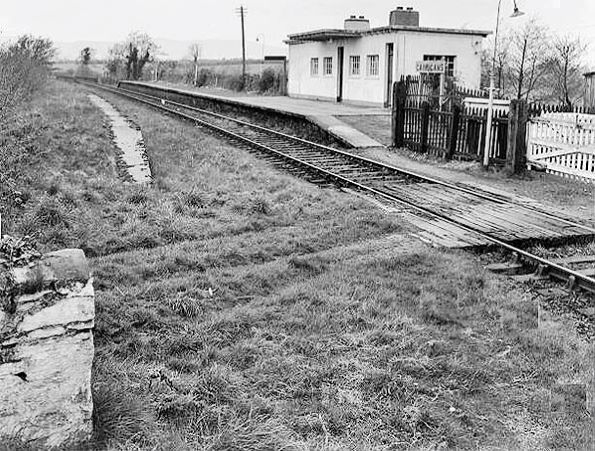 Carrigans station looking west in the Autumn of 1965. The station had closed on 14 February 1965 (with the last stopping services running on Saturday 13 February 1965). Carrigans station looking west in the Autumn of 1965. The station had closed on 14 February 1965 (with the last stopping services running on Saturday 13 February 1965).
Photo from the John Mann collection
Carrigans is a small village, on the north side of the River Foyle, in County Donegal, Ireland. In 1845 the Londonderry & Enniskillen Railway (L&ER) was authorised to build a 59 mile single track line between the city of Derry/Londonderry and Enniskillen and work began in October that year. Construction started from Derry/Londonderry and the course of the line followed the west bank of the River Foyle, passing through Carrigans, to Strabane. The first 14 miles of the single track L&ER line, between Londonderry (Gallows Strand) and Strabane, opened on 19 April 1847. A station was provided to serve the village. It was located to the south-east of Carrigans close to the River Foyle.
At the time of opening there were two other intermediate stations (St Johnston and Carrickmore).
The station was located at the south end of Railway Road (the present day Foyle View Manor Road). A level crossing was provided at the station to provide access to the bank of the River Foyle. It appears that at the time of opening the station facilities were located on the west side of the crossing.
Being a single track line just one platform was provided, which would have been of a low height and quite basic. A stone built building (which survives to this day) located on the east side of the crossing on the north side of the line appears to date from the mid-19th century and therefore it may have been there at the time of opening. The cottage style building possessed a steeply pitched slated roof and its appearance was enhanced by quoins and window dressings in red. It would have provided the booking facilities and staff accommodation.
Carrigans was also provided with goods facilities. They were located to the east of the passenger facilities and were also on the north side of the line. They consisted of a siding and a goods shed.
The time table for March 1850 shows Carrigans as having four trains in each direction. Monday-to-Saturday there were Up trains (southbound) to Strabane at 6.45am (the Sligo Mail), 9.15am, 1.45pm and 4.15pm (the Dublin Mail). The journey time to Strabane was 30 minutes. Monday-to-Saturday Down trains (northbound) to Londonderry (Gallows Strand) departed at 8.10am (The Dublin Mail), 10.45am, 3.15pm and 5.40pm (The Sligo Mail). The journey time to Derry/Londonderry was 15 minutes. On Sundays there was one train each way.
The Derry/Londonderry terminus at Gallows Strand was a mile from the centre of the city and was therefore inconvenient for both passengers and goods. The L&ER opened a ¾ mile extension to a new station, located at Foyle Road close to the centre of the city, on 18 April 1850. During 1850 the L&ER had to improve Railway Road (between the station and the main road to Derry/Londonderry) to stop it being flooded on a regular basis.
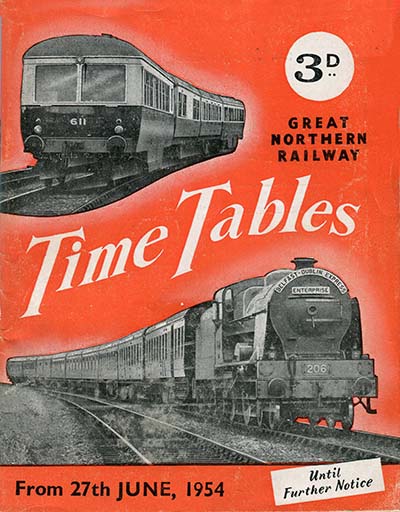 The first section of the L&ER line did not live up to financial expectations and that made progress with the southwards extensions difficult. The first extension south from Strabane opened to Newtownstewart on 9 May 1852 and a few months later, on 13 September 1852, Omagh was reached. The first section of the L&ER line did not live up to financial expectations and that made progress with the southwards extensions difficult. The first extension south from Strabane opened to Newtownstewart on 9 May 1852 and a few months later, on 13 September 1852, Omagh was reached.
On 19 August 1854 the L&ER finally reached Enniskillen.
In February 1859 the Dundalk & Enniskillen Railway (D&ER) reached Enniskillen. This changed things for the L&ER line as it was now connected to Ireland’s capital city, Dublin, as part of a trunk route. The L&ER realised that more efficient running of train services could be brought about if both lines were worked by one company. They entered into negotiations with the D&ER and from 1 January 1860 that company took out a lease on the L&ER line and started to operate the train services. This resulted in through running between Derry/Londonderry and Dundalk with through coaches to Dublin. On 2 September 1861 the Portadown, Dungannon & Omagh Railway completed its route which created a direct route to Belfast.
On 7 July 1862 the D&ER was renamed as the Irish North Western Railway (INWR).
In 1863 Carrigans was being served by only three trains in each direction.
On 1 January 1876 agreement was reached for INWR to be taken over by the Northern Railway (Ireland) and in turn that company merged with the Ulster Railway to form the Great Northern Railway Ireland (GNRI) on 1 April 1876. In 1883 the GNRI bought out the L&ER lease.
The GNRI carried out improvements at Carrigans. They provided a new, higher platform (at what had become the standard height) that was also on the north side of the line but located to the west of the level crossing. The platform was faced with stone and paved along the edge. The surface was made from crushed stone. A new station building, on the platform, may also have been provided at this time.
In 1892 a signal cabin was opened at Carrigans. It was located on the south side of the line to the east of the level crossing. The cabin was of a standard GNRI design with a Railway Signalling Company frame.
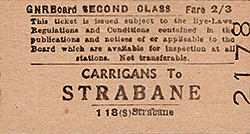 The timetable of December 1895 showed Carrigans as having 5 Up trains Monday-to-Saturday, one of which called by request only. Trains departed at 6.57am for Strabane, at 10.42am for Dundalk at 1.47pm for Enniskillen, at 4.53pm for Clones and at 9.43pm (by request) for Dundalk (via Portadown). In the Down direction there were only 3 trains. They all ran to Londonderry Foyle Road the first departing at 9.34am. There were then trains at 12.20pm and 5.05pm. On Sundays there was only one train, at 9.43pm, which was an Up service to Belfast Great Victoria Street. The timetable of December 1895 showed Carrigans as having 5 Up trains Monday-to-Saturday, one of which called by request only. Trains departed at 6.57am for Strabane, at 10.42am for Dundalk at 1.47pm for Enniskillen, at 4.53pm for Clones and at 9.43pm (by request) for Dundalk (via Portadown). In the Down direction there were only 3 trains. They all ran to Londonderry Foyle Road the first departing at 9.34am. There were then trains at 12.20pm and 5.05pm. On Sundays there was only one train, at 9.43pm, which was an Up service to Belfast Great Victoria Street.
The 1904 Handbook of Stations listed Carrigans as being able to handle general goods and parcels.
In 1907 traffic had become so heavy on the line that the GNRI doubled it between St Johnston and Derry/Londonderry. The doubling of the line required an additional platform. A new Up direction platform was constructed directly opposite the GNRI structure to the west of the level crossing. The platform on the north side of the line became the Down direction platform.
On 4 August 1914 the British Empire declared war on Germany and entered the Great War. From 1 January 1917 the GNRI was taken into British Government control (along with all of the other Irish railways). The GNRI system was used intensely during the war years. Almost as soon as the fighting had stopped, on 11 November 1918, the Irish War of Independence broke out in January 1919. In early 1921 the British Government relinquished control of the GNRI and it was put back into the hands of its directors.
The line’s problems had not gone away however, as by 1922 Ireland was partitioned into two separate countries. As a company the GNRI now found itself operating in both new states. The line through Carrigans between Londonderry Foyle Road and Strabane was particularly problematic. The intermediate stations of the route were all located in County Donegal, which became part of the ‘Free State’. County Tyrone in which Strabane was located, and County Londonderry in which the city of Derry/Londonderry was located, both became part of Northern Ireland. This meant that customs checks had to be made for passengers and goods that were passing between the two countries. Customs facilities were provided at Carrigans station and a ‘Free State’ customs officer was based there.
As if this wasn’t bad enough a Civil War broke out in The Irish Free State in June 1922. This caused further disruption to the railway in County Donegal and it went on until May 1923.
Despite these difficult operating problems, the July 1922 timetable showed 4 Up and 5 Down services Monday-to-Saturday. In the Up direction there was a 7.34am service to Dundalk, an 11.26am train to Clones, a 2.40pm service to Dundalk and a 5.16pm train to Enniskillen. Down trains all ran to Londonderry Foyle Road, departing at 9.39am, 12.53pm, 2.50pm, 5.18pm and at 8.48pm. There was no Sunday service in 1922.
In order to make operations along the line through Carrigans with regards to the border situation less disruptive two important innovations were devised. Many longer distance passenger services ran non-stop between Derry/Londonderry and Strabane which meant that customs checks were not necessary. For goods that were coming into Carrigans from other locations within the Irish Free State the wagons were sealed for their passage through Northern Ireland. Customs officials at St Johnston could then check that the wagons had remained sealed. The same applied to outgoing goods. The same practice was also adopted at Porthall and St Johnston, which disrupted and delayed all traffic.
The 1930s were difficult for the GNRI as they faced industrial unrest and increasing competition from road vehicles.
In 1932 the GNRI provided new station facilities at Carrigans. It’s probable that they replaced an earlier GNRI structure but it is not known why. Located at the eastern end of the Down platform the new building had the clean lines of a debased Art Deco style, painted white as befits such structures, but with the ugliness of a WW2 military building. There was an uncomfortably high wall above the windows giving a top-heavy effect. The flat roof with dentillation extended to form a canopy. Within the building there was a purpose built office for the Customs Officers. The original station building had considerably more charm than its self-assured younger neighbour.
In 1933 the line between St Johnston and Derry/Londonderry was singled (having only been doubled in 1907), partly due to a decline in freight and passenger traffic since partition in 1922. A passing loop was not required at Carrigans, as there was one at St Johnston only two miles away, and the Up line (of 1907) was removed making its platform redundant. The signal cabin (which from 1915 could be switched out at quiet times) was closed.
In 1938 there were 6 Up services Monday-to-Friday. The first Up departure was at 7.30am and the last was at 9.49pm. There was an additional Up departure on Saturdays at 11.25pm. In the Down direction there were 5 trains Monday-to-Saturday all of which ran to Londonderry Foyle Road. The Down services were at 9.35am, 1.35pm, 2.55pm, 4.49pm, and 8.50 pm. There was an additional service on Saturdays only at 7.39pm. There was just 1 train in each direction on Sundays.
During the Second World War there was an upturn in traffic but owing to the Irish Free State being a neutral country maximum use of the route through St Johnston could not be made as war materials and troop trains could not pass that way to the important wartime port of Londonderry.
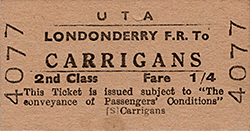 After the war ended in 1945, the railways of Northern Ireland were subjected to even more competition from road transport after war time restrictions were gradually eased by 1950. After the war ended in 1945, the railways of Northern Ireland were subjected to even more competition from road transport after war time restrictions were gradually eased by 1950.
In 1948/9 Nationalisation came to the railways of Northern Ireland, with the notable exception of the GNRI. As the GNRI operated in two separate countries nationalisation of only part of it, that which was in Northern Ireland, would have proved to be difficult. The Ulster Transport Authority (UTA) was set up in 1948 to run transport services within Northern Ireland (including buses and road haulage) and it very quickly showed itself to be a pro-road entity. On 15 January 1950 the entire system of the Belfast & County Down Railway was closed down on the same day, with the exception of branches to Bangor and Donaghadee. Other closures came thick and fast in 1950 when many former NCC lines were closed such as their narrow gauge lines in County Antrim and the former County Down branch to Donaghadee on 22 April 1950. The GNRI, having avoided nationalisation in both parts of Ireland by 1950, did not face the same levels of closure as the other railways of Northern Ireland but financially it was struggling and by 1953 it could no longer continue. From 1 September 1953 the governments of the Republic of Ireland (the Irish Free State had become a full Republic on Easter Monday 1949) and Northern Ireland formed the Great Northern Railway Board (GNRB). The board included equal representation from both governments. The Republic had nationalised all its railways under Córas Iompair Éireann (CIE) in 1950.
The summer timetable for 1954 showed 5 Up services Monday-to-Friday. The first Up train departed at 7.09am for Belfast Great Victoria Street. At 10.32am there was a train for Strabane followed by an Omagh service at 1.39pm. There was another Omagh service at 5.43pm and the final train of the day was a Belfast Great Victoria Street service at 6.55pm. On Saturdays there was an additional Up train which departed at 11.23pm and ran to Victoria Bridge. In the Down direction there were 4 trains Monday-to-Saturday all of which ran to Londonderry Foyle Road. They departed from St Johnston at 9.24am, 2.48pm, 6.34pm and 9.40pm. There were no Sunday services.

The GNRB was unable to stop the losses, the Northern Ireland government was not of a mind to sustain them and economies started to be made. In 1956 Stormont had announced that there would be more closures, which included the route between Omagh and Enniskillen (part of the original route of the L&ER) and these lines, 115 miles in total, were closed during September/October 1957. These severe closures were opposed by the Dublin Government and the GNRB as being unrealistic and economically damaging. At the end of 1957 the Northern Ireland government at Stormont announced that it was going to end the agreement with Dublin that had created the GNRB in 1953.
At midnight on 30 September 1958 the GNRB ceased to exist when the ‘Board’ was wound up and the assets of the company were divided between the UTA of Northern Ireland and the CIE of The Republic of Ireland. The 8 mile long section of the Derry/Londonderry – Strabane line that lay within the Republic of Ireland passed into the hands of CIE. Staff at St Johnston became CIE employees.
Carrigans train services were operated by the UTA. By 1958 there were only 4 local trains in each direction Monday-to-Friday, with an additional Up service running to Victoria Bridge on Saturday evenings only.
The UTA started to use ex-GNRI railcar A for the local services that served Carrigans. The railcar had come into service in 1932 and would be renumbered as 101 by the UTA in October 1961. When Railcar 101 was not available, one of two steam engines that had arrived at Derry/Londonderry with the night goods services would operate these local services instead.
The working timetable of September 1961 showed a reduced service to Carrigans. In the up direction there were two passenger trains on a Monday. Tuesday-to-Saturday there were two ordinary passenger trains and one mixed passenger/goods train. All of the Up services ran to Strabane. In the Down direction there were two passenger trains Monday-to-Friday. On Saturdays there were three, the last of which ran late in the evening. There was also a Down morning goods service that ran from Strabane to Derry/Londonderry and was booked to call at Carrigans Monday-to-Saturday.
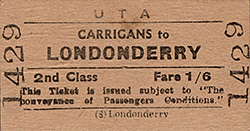 In 1962 the Northern Ireland government commissioned an enquiry into its railways. The enquiry was carried out by Colonel Henry Benson and on 17 July 1963 he published his report (which became known as the Benson Report). The report recommended the closure of the ‘Derry Road’ route. Tyrone County Council supported by other local authorities along the route attempted to stop the closure through dialogue with the Northern Ireland government and when that failed they resorted to court action against the plans of the UTA, who were following orders from Stormont. In 1962 the Northern Ireland government commissioned an enquiry into its railways. The enquiry was carried out by Colonel Henry Benson and on 17 July 1963 he published his report (which became known as the Benson Report). The report recommended the closure of the ‘Derry Road’ route. Tyrone County Council supported by other local authorities along the route attempted to stop the closure through dialogue with the Northern Ireland government and when that failed they resorted to court action against the plans of the UTA, who were following orders from Stormont.
Regular goods services appear to have ceased to serve Carrigans after September 1962, when regular local goods services from St Johnston to Derry/Londonderry ceased. However the station remained open for goods traffic which was worked from St Johnston on an as required basis. Since 1933 the goods siding had been controlled by a ground frame, a key for which was kept at St Johnston signal cabin. The track in the siding was still of the ‘keyed’ type which showed that it had not been replaced since the 19th Century. The UTA would probably have preferred to cease working goods to Carrigans but as the station was a CIE facility they were unable to do so.
From 15 June 1964 the UTA introduced their last summer timetable for services on the Derry Road. Carrigans had no Up passenger services Mondays-to-Fridays. On Saturdays there was one Up service, to Strabane, at 6.22pm. In the Down direction there were 2 passenger trains Mondays-to-Fridays both of which ran to Londonderry Foyle Road. On Saturdays there were an extra 3 Down passenger services from Carrigans (giving 5 trains in total).
In the end the court action that was taken by Tyrone County Council was to fail and closure was announced for 4 January 1965. A second hearing merely staved off the closure for another 6 weeks for passengers only until 14 February 1965. All goods services ceased on 4 January 1965.
From 4 January 1965 passenger trains still operated using the winter timetable (introduced from 7 September 1964). There was still only the one Up passenger service (to Strabane) on Saturdays at 6.22pm. There was one Down service to Londonderry Foyle Road at 2.32pm Mondays-to-Saturdays. On Saturdays there were 3 extra Down trains (giving 4 in total) to Foyle Road. As there was no Sunday service at Carrigans, the last passenger trains ran on Saturday 13 February 1965.
Track lifting took place in late 1965. Both the original station building and the GNRI station building of 1932 much modified survive in 2020. The base of the 1892 signal cabin was also extant in 2020. |

 Home
Page
Home
Page

 Home
Page
Home
Page